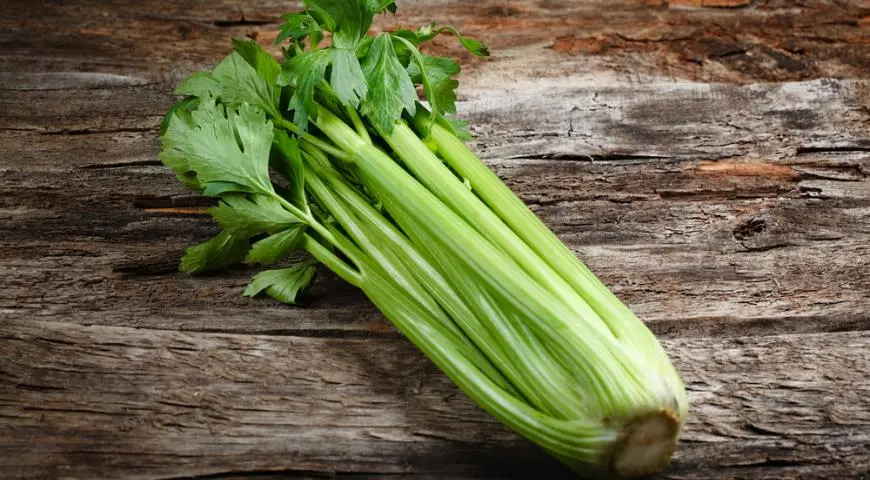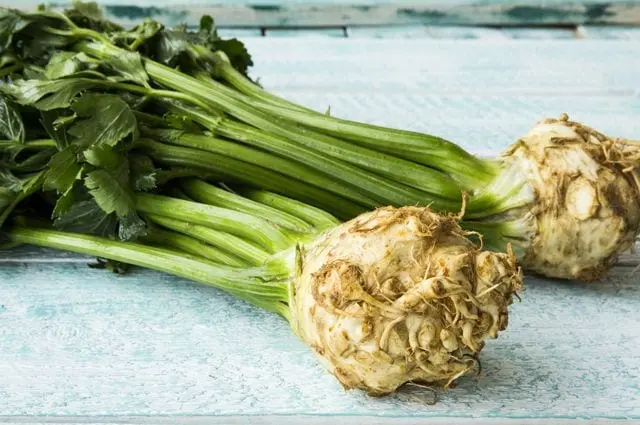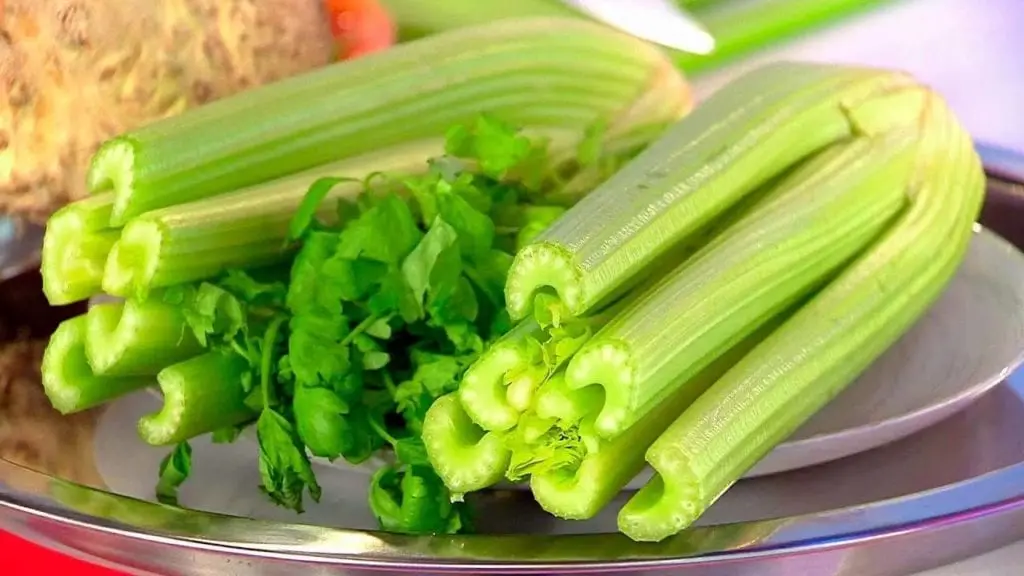Contents
Description
Celery is a biennial plant from the Umbrella family. The homeland of the plant is the Mediterranean, where it still grows in a wild, non-domesticated form.
Celery history
There are about 20 known species of this vegetable. Celery has a large tuber – a root, juicy petioles and tops, similar to parsley. All parts are edible.
Celery was used even in Ancient Greece – they decorated the dwelling to protect against evil spirits, and weaved wreaths for the victors. The plant was believed to bring good luck and was often harvested with garlic and onions.
It was originally used as a medicinal plant, and only in the 17th century it began to be eaten. Celery came to America in the 19th century and began to be cultivated. Celery has its semi-official capital – a city in the state of Colorado, Arvada is called the “celery capital of the world.”
Composition and calorie content
- Calorie content of celery 13 kcal
- Fat 0.1 grams
- Protein 0.9 grams
- Carbohydrates 2.1 grams
- Water 94 grams
- Dietary fiber 1.8 grams
- Organic acids 0.1 grams
- Mono- and disaccharides 2 grams
- Starch 0.1 grams
- Vitamins A, B1, B2, B6, B9, C, E, PP, Beta-carotene
- Minerals Potassium (430 mg.), Calcium (72 mg.), Magnesium (50 mg.), Sodium (200 mg.),
- Phosphorus (77 mg.), Iron (1.3 mg.).
Types and varieties

Petiolate celery is grown for the juicy stalks. It can be green and white, but these are not different varieties: the plant will acquire a white color if it is piled up, covering the petioles with earth. The taste of white celery is more delicate and less bitter than that of green celery, and it lasts longer, therefore it is much more appreciated.
Green and white celery stalks are more juicy and tender than, say, parsley, they are most often used in salads, and the leaves are used as spicy herbs. Celery goes equally well with vegetables, meat, fish, poultry, mushrooms, and is suitable for fatty goose or duck soups. Its exquisite spicy aroma sets off the flavors of beans, eggplant, cabbage, carrots and potatoes.
Root celery is an aromatic and tender root vegetable. It is added to soups, pickles and stews. Freshly grated, it is especially beneficial when combined with grated raw apples (in a one to three ratio), carrots, and herbs. Boiled celery root tastes like potatoes.
Leafy celery (or chive celery) is a plant with medium-sized leaves and a spicy aroma. The leaves are sometimes finely chopped and used to decorate dishes, but more often they are added to salad, soup or sauce.
Celery seeds are also used in cooking – this is an interesting spice. They make, for example, celery salt – a mixture of crushed celery seeds with salt. For the same purposes, you can use dried crushed celery root.
How to choose and store

Root celery goes on sale without petioles, petiolate – as a rule, without a root. All types of celery have a very bright, spicy aroma. The roots and stalks of celery must be strong; leaf and petiole celery should be a delicate light green color.
In order for petioled celery to be well preserved, it is dipped with the bases of the stalks in cold salted water. Otherwise, it will quickly wither in the refrigerator.
Leafy celery is good to buy with roots, in a pot – in this form it is stored longer.
The benefits of celery

Celery contains many vitamins, and vitamin C is in the first place – 100 grams of it contains 8 mg. All parts of the plant contain amino acids and trace elements: boron, calcium, chlorine and others. Celery is rich in fiber and essential oils, as well as vitamins A, E, K and B vitamins.
Eating celery in food increases the vitality of the body, eliminates drowsiness and apathy, and accelerates the elimination of toxic substances. The introduction of celery into the diet is a good prevention of age-related cardiovascular diseases, disorders of water-salt metabolism and inflammatory processes.
Celery is often used in many diets due to its low calorie content and increased metabolism. The juice of this vegetable stimulates the production of gastric juice, which has a positive effect on the absorption of food.
The seed extract is used as an antispasmodic and analgesic agent to reduce muscle spasms, cramps and joint pain. The hypnotic and sedative effect of celery seeds is also known.
Celery is a well-known aphrodisiac that is beneficial for the male body. The plant hormone androsterone increases potency and libido.
Celery harm

There are contraindications for eating celery. The main contraindication is pregnancy and lactation. Celery is not dangerous in minimal quantities, but it is important to limit its consumption.
Celery seeds contain substances that cause uterine contraction and may pose a risk of miscarriage. The substance apiol, found in the stems, tubers and leaves of celery, also causes uterine contractions and can cause bleeding, so it is not recommended to eat celery during menstruation.
People with gastrointestinal diseases should not eat any parts of the plant in their raw form, it is better to heat the vegetable. “
The use of celery in medicine
Celery comes first as a weight loss product. To digest it, more calories are expended than the plant itself contains, which is called “negative calorie content.
100 grams of any part of celery contains about 25 – 32 kcal. Celery dishes are well digested, speed up metabolism, lower cholesterol and remove excess fluid, helping to fight congestion and removing swelling.
Celery is also used in cosmetology. Decoctions and infusions for facial skin and hair strengthening are prepared from it. Juice and decoction of this plant can remove cosmetics from the face, toning and refreshing the skin.
Celery has anti-inflammatory and wound healing properties, accelerating the regeneration of damaged skin. It is used for various skin diseases: allergies, eczema, urticaria.
Celery is an extremely healthy product for the elderly. The effect of celery consumption on lowering cholesterol and blood sugar levels has been proven, which is the prevention of atherosclerosis, diabetes mellitus and cardiovascular diseases.

Celery is useful for people with inflammatory diseases of the joints: arthritis, arthrosis, rheumatism. Substances from celery stalks have a diuretic effect, helping to remove uric acid crystals, which is also useful for patients with cystitis and other diseases of the genitourinary system.
Fresh celery has a positive effect on male sexual activity. This vegetable contains the plant hormone androsterone, which is responsible for the manifestation of secondary sexual characteristics, the level of potency and the synthesis of its own sex hormones.
Essential oils extracted from celery seeds can help reduce pain. Coumarins, which are rich in celery, help with migraines.
Celery is useful for constipation as it has a mild laxative effect. The high fiber content improves the intestinal microflora and accelerates the elimination of toxins and toxins.
The use of celery in cooking
All parts of the plant are eaten, even the seeds are used. Juicy stems and leaves are mostly eaten fresh, while the tuber is often stewed and added to stews and soups. Heat treatment allows people with gastrointestinal diseases to eat this vegetable.
Celery and apple salad

An excellent vitamin salad for light snacks and diets. You can add chopped walnuts and your favorite greens. And for more satiety – curd cheese or mozzarella.
Ingredients
- Celery stalks – 2 pieces
- Fresh carrots – 1 pc
- Sweet and sour apple 1 pc
- Lime – juice from a wedge
- Olive oil, salt, pepper – to taste
Preparation
Wash, peel and cut all fruits and vegetables into medium cubes. Stir, put in a salad bowl. In a bowl, combine olive oil, salt and spices. Season the salad and sprinkle with herbs.









